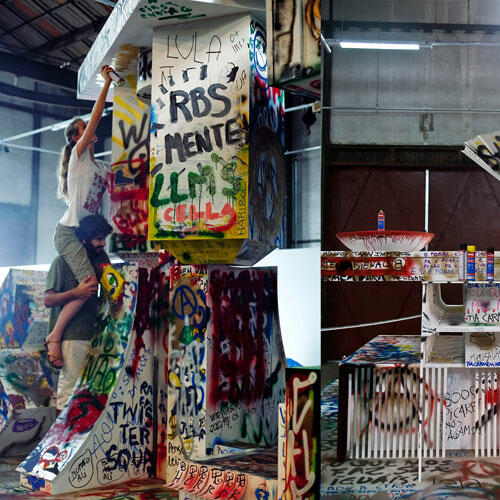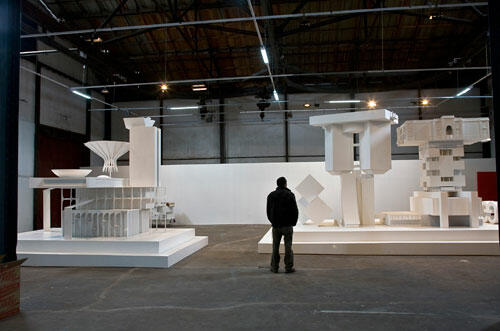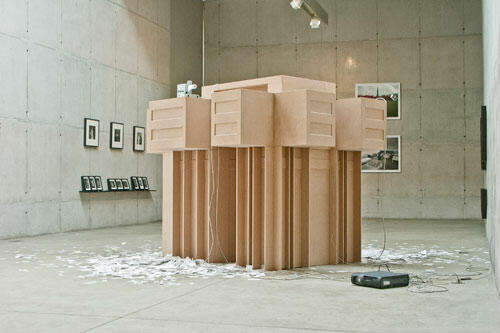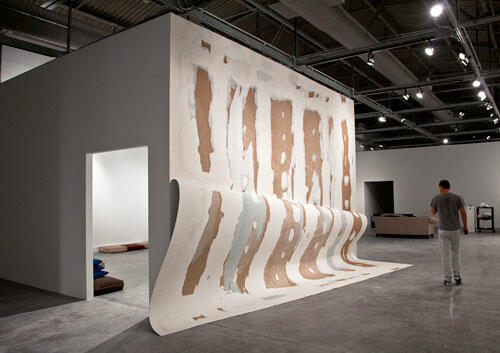José Carlos Martinat
The Barriers of the Social Arena On Abstraction of Power 1 and Abstraction of Power 2
By destruction I understand all those processes that show what we call losses. Traumas which in most cases explain a complete deracination of memories, but which inevitably leave a series of flashes of reminiscences along the way; semi invisible landmarks that evidence the idealization of a traveled road.

This was my opening remark for the text that accompanied the exhibition I curated in the Seventh Mercosur Biennial, 2009. On that occasion, the focus of the exhibit was the notion of transformation, both from the visual point of view of the works and from that of their production systems and of all the possible extensions rendering the visibility of the socio-cultural context of the state of Río Grande do Sul possible. Thus, all the participating works were altered, modified, manipulated or destroyed over the course of the exhibition. In that framework, which was so visually attractive and so evidently dogmatic (I say this with a certain feeling of shame), José Carlos Martinat’s project became a point of attraction which allowed many connections with the rest of the works presented.
Monumentos vandalizables: Abstracción de poder 1, Abstracción de poder 2 (Vandalizable Monuments: Abstraction of Power 1, Abstraction of Power 2)(2009) consisted of two groups of (monumental) sculptures gathering together models of emblematic buildings, representative of Brazilian political and economic power. Modernity and development are the vectors that outline the first references of this project.
Each of these models, however, had been stripped of its original physical appearance; every trace of ornament had been eliminated, transforming all the surfaces into spaces neutralized by a museum-like white, by an architecture free from any kind of crime − as Adolf Loos would put it − against the image.
The white sculptural ensemble remained that way for a few hours. Once the biennial was inaugurated, the piece was daily manipulated by different groups of people, representatives of trade union movements, peasants, students, and by the public at large attending the exhibit. “Guests”, as Martinat wished to call them. In this way, the Tasso Corrêa Academic Center (Art Institute, Federal University of Rio Grande do Sul), the State Teachers Union, the Landless People’s Movement, the “Muralla Negra” group, the Mural Painting Nucleus (acronym in Portuguese NPM), the Central Students’ Board (DCE-UFRGS); the National Movement of Housing Vindication (MNLM), the Black Students group, the Cooperarte group, the Gaúcha Anarchist Federation (FAG) and the Confederação Operária Brasileira (Brazilian Workers Confederation)(COB) represented a wide range of communities that made use of the platform offered by the artist to broaden and convey their claims to the Biennial’s space.
Evidently, the “empowerment” of non-artistic groups in an institutional space, even though the nature of the show in general was that of a significant leap into experimentality, was extremely controversial due to the fact that, in the first place, the sculptural ensemble lost all formal validity. A reference to the modern spirit that inspired the buildings gathered together in the work no longer existed. All this was eliminated for the second time and buried by the synthetic enamel paint spray, by the permanent markers, by the pamphlets glued to the surfaces and the masses that ravaged everything they encountered. In the same way, what followed was a new erasure. An over-saturation of interventions; an extra-vandalization that allowed the gradual creation of a new space of chromatic homogeneity susceptible of being subjected to a new intervention.
It is through this procedure, resulting exclusively from the space for interaction that Martinat offered to his “collaborators”, that the work may be read as reversible. That is, a highly ductile terrain that has the capacity to redefine itself once it is saturated. These shifts, these changes in appearance are, therefore, what makes it possible to think of a “paranoid work”, a project revealing self-referential deliriums, since the circularity of the work clearly proposes a territory finally closed to its actors and to their actions, and so on.
This level in which the work goes beyond the populist pleasure that any work boasting to be relational can enjoy generates a very significant tension with politics in an immediate way, for as Boris Groys would say, “The problem is not art’s incapacity to become truly political. The problem is that today’s political sphere has already become aestheticized.” The political discourse is a by-product of the institution of the image, and consequently, the role of art when it pretends to be political is to acknowledge, in the first place, that monopoly over the image no longer belongs to it. Works such as these are inside and outside art, and inside and outside politics at the same time. In this pulsation, the old role of the artist has been disfigured by the loss of his power as exclusive producer of images; I am thinking, particularly, of each group of collaborators Martinat has availed himself of to complete his work. Here the images cannot even be considered found objects. The visual element in Abstraction of Power 1 and Abstraction of Power 2 corresponds to the momentum and the energy of the image of contemporary politics, to the value of “personal vandalization” as a war trophy and a possession mark. Then, it is the surface of this sculptural group that is not Martinat’s property, and for this reason, his responsibility in this work is only partial. Rather, he is responsible for the initial blank block minutes before it is intervened in.
Precisely at this point, at this moment when the work ceases to be an autonomous art object, precisely when the first social demand is painted in fluorescent orange on the white plywood model, the destruction of art makes its appearance and political aesthetics is fully displayed.
Today, after revisiting the project presented at the Museum of Art in Lima-MALI in 2010, I think this capacity the work has to “receive blows” has functioned smoothly because it bears and endures the traumas, the inconveniencies and the personal and collective tragedies of the immediate context that harbors it. It is in its nature to absorb all that which “is in the air”, to receive with no editorial delicacy all that its surfaces can endure.
The three works, Abstraction of Power 1, 2 and 3, constitute a great barrier for the storms of the social arena which inexorably cover art.
José Carlos Martinat (1974)
Lives and works in Mexico.
He began his artistic career as a photographer, later to shift his focus to the field of installation involving sculptural objects that incorporate digital mechanisms for capturing and processing information, and including experiences of collective work and others characterized by a strong element of appropriation.
His works have circulated permanently in Latin America, the United States and Europe, exhibiting a critical vision of Peru’s political life and especially of the country’s contemporary society.
His recent projects, such as those presented at Miami’s MOCA (2011), where he has peeled all the layers of stucco and paint off a section of museum wall, symbolically and literally dismantle the institutional character of art.
In the same way, for the reopening of MALI in Lima (2010) and for the 7th Mercosur Biennial, he has made use mainly of graffiti and other popular forms of expression to work with the specificity of the context.
Martinat is currently represented by Leme Gallery in Sao Paulo and Revolver Gallery in Lima.
-
 Abstracción de poder 1 y 2, 2009. Sculptures, spray cans, markers and paint buckets. 7th Mercosur Biennial. Courtesy the artist.
Abstracción de poder 1 y 2, 2009. Sculptures, spray cans, markers and paint buckets. 7th Mercosur Biennial. Courtesy the artist.
Abstracción de poder 1 y 2, 2009. Esculturas, latas de aerosol, marcadores y baldes de pintura. 7° Bienal del Mercosur. Cortesía del artista. -
 Abstracción de poder 1 y 2, 2009. Sculptures, spray cans, markers and paint buckets. 7th Mercosur Biennial. Courtesy the artist.
Abstracción de poder 1 y 2, 2009. Sculptures, spray cans, markers and paint buckets. 7th Mercosur Biennial. Courtesy the artist.
Abstracción de poder 1 y 2, 2009. Esculturas, lastas de aerosol, marcadores y baldes de pintura. 7° Bienal del Mercosur. Cortesía del artista. -
 Abstracción de poder 1 y 2, 2009. Sculptures, spray cans, markers and paint buckets. 7th Mercosur Biennial. Courtesy the artist.
Abstracción de poder 1 y 2, 2009. Sculptures, spray cans, markers and paint buckets. 7th Mercosur Biennial. Courtesy the artist.
Abstracción de poder 1 y 2, 2009. Esculturas, lastas de aerosol, marcadores y baldes de pintura. 7° Bienal del Mercosur. Cortesía del artista. -
 Abstracción de poder 1 y 2, 2009. Sculptures, spray cans, markers and paint buckets. 7th Mercosur Biennial. Courtesy the artist.
Abstracción de poder 1 y 2, 2009. Sculptures, spray cans, markers and paint buckets. 7th Mercosur Biennial. Courtesy the artist.
Abstracción de poder 1 y 2, 2009. Esculturas, lastas de aerosol, marcadores y baldes de pintura. 7° Bienal del Mercosur. Cortesía del artista. -
 Scale sculpture of Peru’s Intelligence Service, thermal printer, CPU, web search program, cables, PIR sensor. Installation view, Leme Gallery. Courtesy the artist.
Scale sculpture of Peru’s Intelligence Service, thermal printer, CPU, web search program, cables, PIR sensor. Installation view, Leme Gallery. Courtesy the artist.
Escultura a escala del Servicio de Inteligencia del Perú, impresoras térmicas, CPU, programa de búsqueda web, cables, sensor PIR. Vista de la instalación, Galería Leme. Cortesía del artista. -
 Removal of peeled-off layer of museum wall. View of MOCA Museum - Miami. Courtesy the artist.
Removal of peeled-off layer of museum wall. View of MOCA Museum - Miami. Courtesy the artist.
Extracción de capa de pared de museo. Vista Museo MOCA - Miami. Cortesía del artista. -
 Portrait of José Carlos Martinat. Rancho Studio, founded with Miguel Andrade in Mexico DF. Space for creative exploration in different media. Courtesy the artist.
Portrait of José Carlos Martinat. Rancho Studio, founded with Miguel Andrade in Mexico DF. Space for creative exploration in different media. Courtesy the artist.
Retrato José Carlos Martinat. Rancho Estudio, fundado con Miguel Andrade in México DF. Espacio para la exploración creativa en medios diversos. Cortesía del artista.




